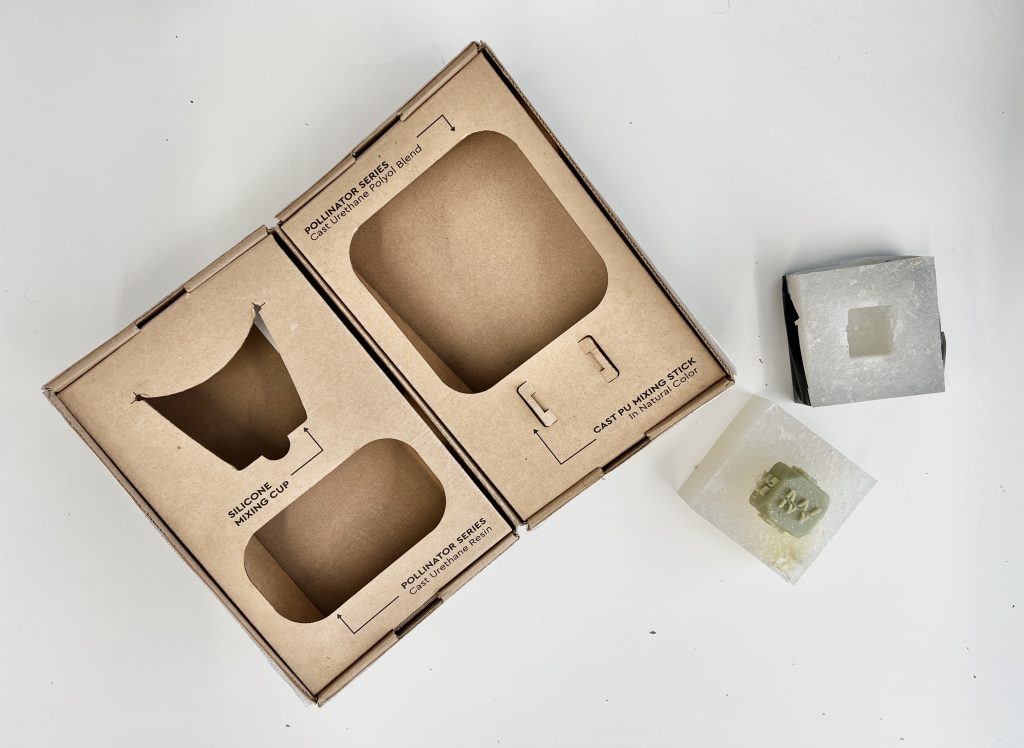At Interwoven Design we like to incorporate sustainability into our process wherever possible, and this includes sustainable prototyping. In this article we outline our casting process and review the Checkerspot Pollinator Kit, a renewable polyurethane resin that can be used for casting. Our clients rely on us to develop innovative solutions quickly and economically, which means that we move from sketches to prototyping quickly. We iterate potential design directions in-house to reduce turnaround time and keep product development costs low. Making urethane casting molds in-house allows us to do small batch prototyping and testing at a low cost before sending a more resolved solution out to a casting or injection-molding contractor, saving our clients time and money.
How does the casting process work?
Once a design direction has been finalized and is translated into 3D CAD (Computer Aided Design) software, we choose one of two casting strategies:
- We design and 3D print a mold based on the negative of the component
- We 3D print the component itself and then make a mold from it
The approach we choose is driven by the needs of the final component and the intended manufacturing material. If the final component is meant to be flexible or semi-rigid, like a high density foam part, we print the mold, as a flexible component can be removed from a rigid mold. If the final component is intended to be rigid, we print the part and cast a mold from it, as a flexible mold can be removed from a rigid component.
Once approach is set, the two-part urethane is mixed in the directed ratio to start the chemical reaction that cures the material, turning it from liquid to solid. If we want to tint our resin to more closely approximate the final product, we tint the parts before combining them as urethane can set quickly. The mix is poured carefully into the mold, trying to avoid bubbles that could detract from the final casting. The curing time can vary but it’s good to leave the casting for the maximum time specified as thinner elements will cure more quickly than thicker ones. In later stages of development the casting may be sanded, painted, or finished in some other way to make the prototype feel as close to the final product as possible.

Incorporating sustainable practices
We consider environmental impact throughout the design process, pushing for the products we design to be sustainable to the greatest degree achievable for a given project. Considering sustainability at every stage of a product development cycle is essential to discovering opportunities for environmentally thoughtful design. These stages include research, form, construction, material selection and sourcing, manufacturing, and more. In early stages of a project, finding sustainable strategies for a development phase can take extra time and be restricted by budgets and practical constraints within the project.
Access to sustainable materials that facilitate low volume in-house casting is a game changer, as the more closely we can approximate final materials, the more accurate our product testing becomes. Not only does it allow our designers and clients to hold, wear and interact with the product, but it allows for high-fidelity field testing and validation. Depending on the product category, a client may choose to test products in-house with their own teams or outsource testing to a team of engineers. The ability to quickly generate and iterate prototypes that closely or precisely mimic the final material keeps testing costs down and helps projects stay on schedule.

Checkerspot performance casting materials
Checkerspot is a company that focuses on sustainable, high-performance casting materials, serving makers, designers and fabricators. Their innovative materials feature over 50% bio-based, renewable content, challenging a market saturated with oil-derived materials. They manufacture materials by “optimizing microbes to manufacture unique structured oils produced in nature, but not previously accessible at commercial scale.” Each organism contains oil that can be extracted, these lipids are the key component to Checkerspot’s biomaterials. Optimizing the qualities of sustainable materials like algal oil allows for peak product performance for the intended user as well as the environment.
The Checkerspot Pollinator Kit
We had the opportunity to put Checkerspot’s Pollinator Series Cast Urethane to the test in our studio. Our designer’s appreciated the thought put into the labeling of the kit components and instructions for the mixing and casting processes. We also liked the smooth user interaction with the sustainable packaging design. When we poured the mix into our intricate mold, the materials cured evenly and captured fine details, proving that there is no need to sacrifice performance when using sustainable alternatives to mainstream oil-derived casting products.
There you have it!
Here at Interwoven we enjoy pushing the boundaries between design, sustainability, material science and technology. Playing with new materials invigorates our design process as well as our studio-practice. Have you tried working with a new sustainable material recently? Tell us about it! Prototyping sustainably with 3D printing and bio-based material casting is just one way we can participate in the movement towards more responsible, environmentally considerate design.
Check out our Insight posts to learn more about what we do at Interwoven Design. Sign up for our newsletter and follow us on Instagram and LinkedIn for design news, multi-media recommendations, and to learn more about product design and development!

